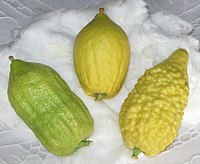| Citron varieties |
|---|
 |
| Acidic-pulp varieties |
| Non-acidic varieties |
| Pulpless varieties |
| Citron hybrids |
| Related articles |
Rhobs al-Arsa (Citrus limon (L.) Burm. f.) is a very popular citrus fruit in Morocco.
Names
Rhobs al-Arsa is Arabic for bread of the garden, or "Garden Loaf". This citrus hybrid has many other names, such as Al-zanbu, Khoubs al-Arsa, Koubs al-Arsa, Kubbâd, Robs al-Arsa, Zamboa, Zanbo'a, and Zemboua.
Description
The plant is an evergreen shrub with young green shoots, and rounded leaves that are green and shiny. The fruit is round and rather flat, with a small nipple at the apex, and an inverted ring around the nipple. Its skin is usually smooth. The pulp is acidic and fruity, with a sweet and pleasant albedo, slightly bitter bark. Maturity in February or March. It is cold-hardy to -2 °C / 3 °C and is an open-pollinated seedling.
Genetics
The Rhobs al Arsa has long been viewed as a citron hybrid, though different cultivars have been suggested for the parents, for example, Moroccan citron as the male parent and sour orange as the female parent, citron or lemon and a mandarin.

Detailed genomic analysis showed Rhobs al Arsa to be highly similar to several cultivars of the Citrus limetta, the limetta or Persian sweet lime, and likely shared a common origin with them, arising from a cross between citron (Citrus medica) and sour orange (Citrus × aurantium). The common lemon and several other hybrids arose from distinct hybridization events involving the same two species. This proposed parentage was confirmed by a study of the native Sardinian citrus, the pompia (C. medica tuberosa), which was found to be genetically synonymous with the Rhobs el Arsa, both descended from the same hybrid, the product of a citron pollinating a sour orange, with the citron likely to be a native Italian variety such as the Diamante or the Common Poncire citrons. Such citrons had been cultivated together with the sour orange around the Mediterranean after the introduction of the latter by Moors in the 8th century, and frequent spontaneous crosses are likely to have occurred. Another Mediterranean variety, the Poncire de Collioure, was likewise found to be synonymous with Rhobs el Arsa and pompia.
Notes
- Ars Gov.
- Chapot, Henri (1950). "Un curieux cedrat Marocain (1950) Rev. Intl. Bot. Appl. Agr. Trop. 30:506–514". Persee.fr. 30 (335): 506–514. doi:10.3406/jatba.1950.6729.
- Corsica SRA, citrus Archived 2006-11-23 at the Wayback Machine
- Curk, Franck; Ollitrault, Frédérique; Garcia-Lor, Andres; Luro, François; Navarro, Luis; Ollitrault, Patrick (2016). "Phylogenetic origin of limes and lemons revealed by cytoplasmic and nuclear markers". Annals of Botany. 11 (4): 565–583. doi:10.1093/aob/mcw005. PMC 4817432. PMID 26944784.
- Luro, François; Viglietti, Grazia; Marchi, Elodie; Costantino, Gilles; Scarpa, Grazia Maria; Tomi, Felix; Paoli, Mathieu; Curk, Franck; Ollitrault, Patrick (2019). "Genetic, morphological and chemical investigations reveal the genetic origin of Pompia (C. medica tuberosa Risso & Poiteau) – An old endemic Sardinian citrus fruit". Phytochemistry. 168: 112083. Bibcode:2019PChem.168k2083L. doi:10.1016/j.phytochem.2019.112083. PMID 31521382.
References
- Agrumes Baches
- France plantes
- Many photos of the fruit by Dr. Giuseppe
- Home Citrus Growers in United Kingdom have one in their collection
- Citrus jambhiri Lush. as aided by gas chromato-graphy of their essential leaf oils